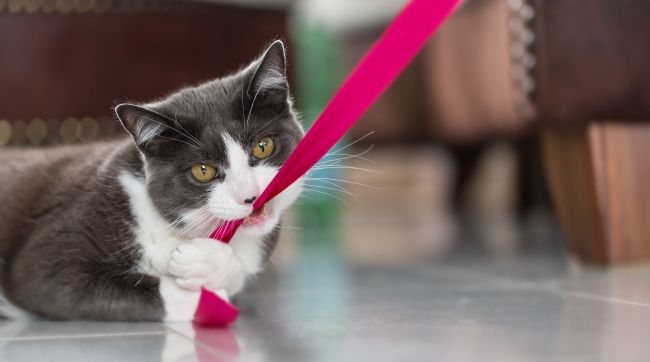
As many cat-owners can attest, certain household objects seem to be oddly enticing to cats. Though their food bowls may be full and there is no shortage of treats, some felines are still inclined to bite, chew and even ingest unusual items. Why do cats eat strange things? Veterinarians and behaviorist call this inclination “pica.”
What is “pica?”
When a cat habitually eats, chews, or sucks on objects that should have no particular nutritional value or even a “tasty” appeal, the behavior is known as “pica.” The desire to eat non-food objects is fairly common among domestic felines, and can consist of a cat sucking on wool stockings, chewing paper towels, biting wood or rubber bands, etc. Other cats might prefer cottony shoe laces, leather strings, rubber cords, shower curtains, or plastic bags. Most cats who show signs of pica, are usually below the age of two years, but even adult and senior cats can develop the disorder. Though there seems to be no rhyme or reason behind it, cat pica may be the result of a behavioral or psychological disorder, or may have something to do with the cat’s health and nutrition.
What causes a cat’s inclination to pica disorder:

Diet issues: They say pregnant women crave dirt when their bodies are low on iron. Similarly, when a cat is lacking some vitamin or mineral, he may be inclined to search for it elsewhere. Cats that sample their cat litter (a vile concept, we know!) are said to suffer from an iron deficiency. When felines bite and chew plant leaves, they might also be lacking a balance of healthy vitamins in their daily diet. Another reason might be that the cat simply isn’t being given enough food.
Behavioral issues: Some felines develop nervous habits, such as over-grooming and scratching, so that they end up with hot-spots on their fur, and severely shredded furniture. Pica can also occur simply from just out of bad behavior or misguided energy. A cat might be doing chewing objects out of boredom, or when they are trying to get your attention about something. They might need to try a new game, or have more (supervised) outdoor activities with you, as they may just feel cooped up.
Psychological issues: Anxiety and fear can cause cats to behave out of the ordinary. Cats who were weaned prematurely, or were separated from their mothers at an early age, tend to search for the comfort of nursing. This they do by sucking on wool, stuffed animals, or even their owner’s clothes, gloves, or shirt collars. Stressful environments (which may include outbursts of anger or routinely loud or high-pitched noises), separation anxiety, and sudden changes like moving-house, may also drive cats to pica, since trauma can cause animals to revert to comfort-seeking stages.
Genetic predispositions: Though not every cat struggles with pica, observations have been made that some breeds are more disposed to this compulsive disorder of eating non-food items, based on their genetics. Certain Oriental breeds (such as Siamese cats) seem predisposed to cat pica than other felines do. Whatever the reason may be, if your feline routinely eats damaging objects, a veterinarian should be notified so that no further harm comes to the kitty’s intestines or digestive tract.

